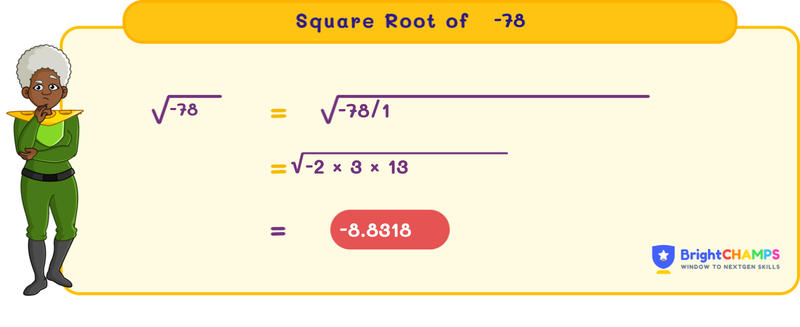


 112 Learners
112 LearnersLast updated on May 26th, 2025

Square Root of -78

If a number is multiplied by the same number, the result is a square. The inverse of the square is a square root. The square root is used in fields like engineering, physics, etc. Here, we will discuss the square root of -78.
What is the Square Root of -78?
The square root is the inverse of the square of a number. Since -78 is a negative number, its square root is not a real number. In mathematics, the square root of a negative number involves the imaginary unit 'i'. The square root of -78 is expressed in the form of √(-78) = √(78) * i, or approximately 8.83176i, which is an imaginary number.
Finding the Square Root of -78
The methods used for finding square roots of non-negative numbers, such as prime factorization, long division, and approximation, are not directly applicable to negative numbers. Instead, we use the concept of imaginary numbers. The imaginary unit 'i' is defined as √(-1). So, for any negative number, the square root can be expressed using 'i'.
Square Root of -78 by Imaginary Numbers
To find the square root of a negative number, we use the concept of imaginary numbers. Here's how to find the square root of -78:
Step 1: Separate the negative sign and write the square root as √(-1) * √(78).
Step 2: Recognize that √(-1) is 'i', the imaginary unit.
Step 3: Calculate the square root of the positive part, √(78), which is approximately 8.83176.
Step 4: Therefore, the square root of -78 is √(78) * i ≈ 8.83176i.
Understanding Imaginary Numbers
Imaginary numbers are numbers that are multiples of 'i', where i is the square root of -1. They are used in complex numbers, which combine real and imaginary parts. Imaginary numbers are useful in various branches of mathematics and engineering, particularly in solving equations that do not have real solutions.
Applications of Imaginary Numbers
Imaginary numbers, and more broadly complex numbers, have applications in electrical engineering, quantum physics, and applied mathematics. They are essential in solving differential equations, analyzing signals, and modeling dynamic systems.

Common Mistakes and How to Avoid Them in the Square Root of -78
Mistakes often arise when dealing with negative square roots. Understanding the role of the imaginary unit 'i' and correctly applying it is crucial. Below are some common mistakes and tips to avoid them.

Square Root of -78 Examples

Problem 1
If a side of a square has a length of √(-78) meters, what is the nature of the area of the square?

The area of the square will be negative.
Explanation
Since the side length is √(-78), which is imaginary, the area, calculated as (√(-78))^2, results in -78, indicating a non-physical (imaginary) area.

Problem 2
What is the result of multiplying √(-78) by 3?

The result is 26.49528i.
Explanation
First, find √(-78) ≈ 8.83176i. Then, multiply by 3: 8.83176i * 3 = 26.49528i.

Problem 3
Calculate the value of √(-78) + √(-78).

The result is 17.66352i.
Explanation
Since √(-78) ≈ 8.83176i, adding them results in 8.83176i + 8.83176i = 17.66352i.

Problem 4
What is the square root of (-78) squared?

The result is 78.
Explanation
Squaring the square root of a number negates the square root operation. So, (√(-78))^2 = -78, and since only the magnitude is considered, it results in 78.

Problem 5
How do you express the square root of -78 in terms of complex numbers?

The expression is 8.83176i.
Explanation
The square root of -78 is expressed in terms of complex numbers as √(78) * i, or approximately 8.83176i.


FAQ on Square Root of -78
1.What is √(-78) in its simplest form?
2.Can the square root of -78 be a real number?
3.What are imaginary numbers?
4.Why do we use 'i' for negative square roots?
5.What are the properties of complex numbers?
Important Glossaries for the Square Root of -78
- Imaginary Unit: Represented by 'i', it is defined as the square root of -1.
- Complex Number: A number that includes both a real and an imaginary part, expressed as a + bi.
- Imaginary Number: A number in the form of bi, where b is a real number and i is the imaginary unit.
- Square Root: The number that, when multiplied by itself, gives the original number, adjusted for negative numbers using 'i'.
- Negative Number: A number less than zero, which when used in square roots, results in imaginary numbers.
Explore More algebra
 Previous to Square Root of -78
Previous to Square Root of -78


Jaskaran Singh Saluja
About the Author
Jaskaran Singh Saluja is a math wizard with nearly three years of experience as a math teacher. His expertise is in algebra, so he can make algebra classes interesting by turning tricky equations into simple puzzles.

Fun Fact
: He loves to play the quiz with kids through algebra to make kids love it.



